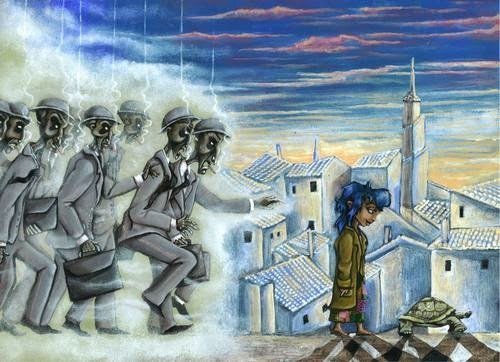The child who knows how to listen to what you say: Who is Momo?
Momo was first published in 1973. The full name of the book is Momo or The Curious Tale of the Time Thieves and the Boy Who Brings Stolen Time Back to People. This name is also the shortest summary of the book.

Micheal Ende says, “I tell my stories for the child inside me and for all of us.” Momo is a story written for all of us and it tells us all.
So who is Momo?
He is a homeless child. He has no mother or father. His aunt, uncle, grandmother, or another relative. Eight years old or twelve years old? Even that is unknown. When asked about his age, Momo pauses for a moment and says, "As far as I remember, I have always existed." But you know, adults have always been too interested in numbers, they're not convinced. When asked persistently, Momo says "face" this time. Everyone thinks it's a joke. They ask again. “One hundred and two,” he says this time. They think that he doesn't know numbers because no one taught him and that he doesn't know anything other than a few numbers heard by hearsay. Only then will he be convinced and leave him alone.
Michael Andreas Helmuth Ende (12 November 1929 – 28 August 1995) was a German writer of fantasy and children's fiction. He is known for his epic fantasy The Neverending Story (with its 1980s film adaptation and a 1995 animated television adaptation); other well-known works include Momo and Jim Button and Luke the Engine Driver. His works have been translated into more than 40 languages and sold more than 35 million copies.
Momo runs away from a kindergarten he describes as "there were always bars on the windows" and settles in a historical amphitheater far from the city. He quickly becomes friends with the kind-hearted people around him. More precisely, Momo becomes an indispensable part of their lives. So much so that the sentence "Go and visit Momo's" turns into an expression that is said every day, at any time, as a greeting or farewell. Those who have a problem go to Momo, those who are offended make up with her, and children play their best games when he is with Momo.
There is something that distinguishes Momo from other children and even from all other people. This thing he has accomplished like no one else can is listening. The difference is that “Momo listens to others in a way that makes even stupid people think of bright thoughts.”
Listening, loving, accepting, and forgiving are the things Momo does best. While having more and even 'having more with greater speed' is being imposed, Momo struggles to stand against this and remain as he was created. And yes, that's why Momo's story is our story.
Criticism of Momo and Modernism
Although it has various definitions, modernism, in the crudest terms, is the glorification of reason and secularization. It is the removal of God from the center of society and its replacement with science. Alain Touraine summarizes the relationship between religion and modernism as follows: "The idea of modernity leaves a place for religious beliefs - at best - only within private life." However, modernism aims to free the individual from the bonds of not only religion but also all kinds of social ties, traditions, and emotions.
Big Secret: Time
The book attaches special importance to the concept of time and places it at the center of the text. “There is a great secret in this day. This great secret is time. Clocks and calendars have been made to measure it, but they mean nothing. Everyone knows very well that sometimes an hour seems as long as a lifetime, and sometimes it passes in the blink of an eye. Because time is life itself. And the place of life is the heart.”
What's the Difference of Momo?
Momo, like all good books, is written for everyone who can read from seven to seventy. The book exalts solidarity against the individualism of modernism. He aspires for 'good', not 'much'. It brings conviction against capitalism that says 'Ask for more'. He makes a silent old man and a talkative young man two close friends and says 'It is possible to be together with differences' against standardization.
While doing all this, he does not compromise on literature, adventure, excitement, childlike innocence, and simplicity. It is these features that have brought Momo together with readers of all ages since the day it was written.
Momo is also proof that every thought can be expressed to all ages. The book, which has been translated into dozens of languages, is also an indication that goodness can be expressed in the same way in every language.
